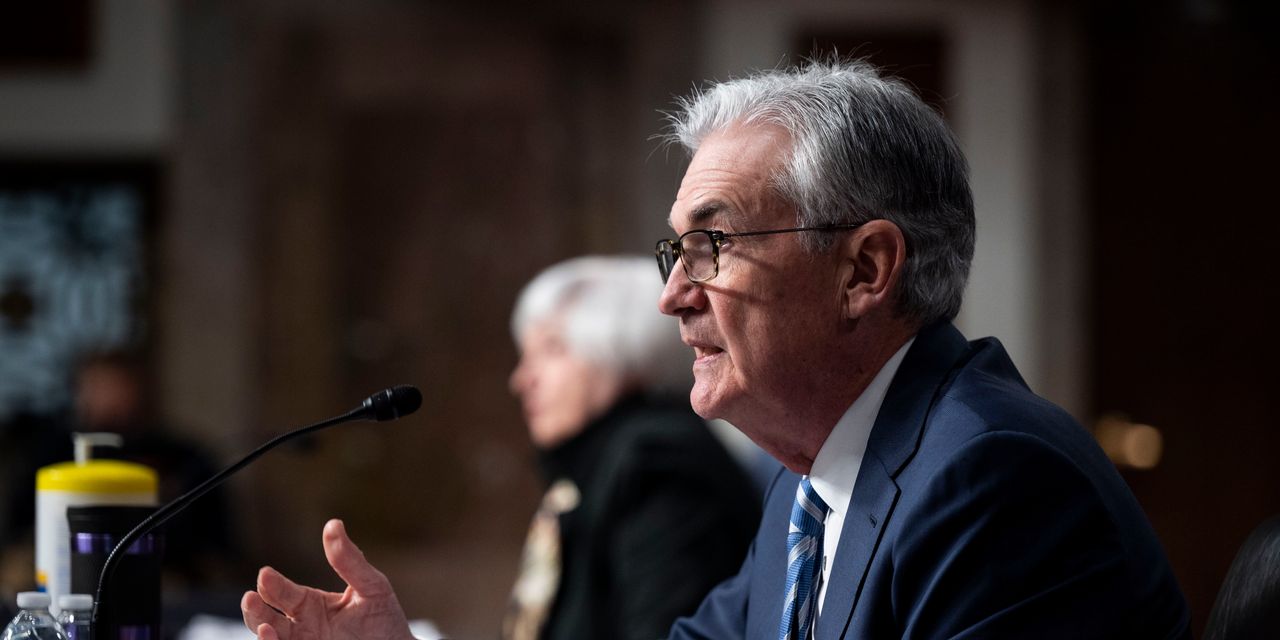
Federal Reserve officials at their meeting last month eyed a faster timetable for raising interest rates this year, potentially as soon as in March, amid greater discomfort with high inflation.
Minutes of their Dec. 14-15 meeting, released Wednesday, showed officials believed that rising inflation and a very tight labor market could call for lifting short-term rates “sooner or at a faster pace than participants had earlier anticipated.”
Some officials also thought the Fed should start shrinking its $8.76 trillion portfolio of bonds and other assets relatively soon after beginning to raise rates, the minutes said. Investors would see the move as another way for the Fed to tighten financial conditions to cool the economy.
SHARE YOUR THOUGHTS
How would you rate the Fed’s handling of monetary policy in 2021? Join the conversation below.
Stocks turned sharply lower after the minutes were released Wednesday afternoon. The blue-chip Dow Jones Industrial Average fell 1.1%, while the tech-heavy Nasdaq Composite Index lost 3.3%.
Meanwhile, government bond yields rose Wednesday. After the minutes were released, trading in interest-rate futures markets implied a roughly two-thirds probability that the Fed would raise rates in March, according to CME Group.
Julia Coronado, founder of economic-advisory firm MacroPolicy Perspectives, said that the minutes prompted her to move up her forecast for rate increases to begin in March, instead of June.
“The Fed is on a glide path to hiking in March,” said Neil Dutta, an economist at research firm Renaissance Macro. “It is hard to see what is going to hold them back.”
Most central bank officials, in projections released after last month’s meeting, penciled in at least three quarter-percentage-point rate increases this year. In September, around half of the group thought rate increases could wait until 2023.
For months, Fed leaders stuck to a view that higher price pressures in 2021 were caused primarily by supply-chain bottlenecks and would ease on their own. But Fed Chairman Jerome Powell had before the meeting signaled much less conviction about that forecast, and other officials last month broadly shared his views.
“While participants generally continued to anticipate that inflation would decline significantly over the course of 2022 as supply constraints eased, almost all stated that they had revised up their forecasts of inflation for 2022 notably, and many did so for 2023 as well,” the minutes said.
One immediate sign of their concerns could be seen from plans they approved at that meeting to more quickly scale back, or taper, their asset purchases. The program is now on track to end in March instead of June.
The Fed wants to end the bond-buying program, a form of economic stimulus, before it lifts short-term rates to curb inflation. “The whole point of accelerating the tapering was…so the March meeting could be a live meeting” to raise rates, said Fed governor Christopher Waller in remarks on Dec. 17. “That was the intent.”
Officials in their postmeeting statement described their goal of inflation moderately exceeding their 2% target as being met, one of two key criteria the central bank has laid out to justify raising rates.
The minutes showed that most officials believe they could “fast approach” their second goal of achieving labor market conditions consistent with maximum employment if recent hiring progress continues.
Several officials said last month that higher inflation pressures could force the Fed to raise rates before the employment goal had been met, and some officials thought it had already been met, according to the minutes.
The shift is the latest sign of how an acceleration and broadening of inflationary pressures, amid a tight labor market, have reshaped officials’ economic outlook and policy planning.
Fed officials’ decision to take their foot off the gas more quickly reflects a shifting calculus about the potential for stronger demand to push up prices—such as wages and rents—even after supply-chain bottlenecks and shortages of items such as cars abate.
Brisk demand for goods, disrupted supply chains and various shortages have pushed 12-month inflation to its highest readings in decades. Core consumer prices, which exclude volatile food and energy categories, were up 4.7% in November from a year earlier, according to the Fed’s preferred gauge. That is well above both the Fed’s 2% target and officials’ stated desire to have inflation run slightly above that target.
“There’s a real risk now, I believe, that inflation may be more persistent and…the risk of higher inflation becoming entrenched has increased,” said Mr. Powell at a news conference on Dec. 15.
While officials last month cited the Omicron variant of the coronavirus as a risk, the minutes suggest officials didn’t see it as a serious headwind for the economy.
The minutes also provided more detail around preliminary discussions officials had last month over how and when to shrink their $8.76 trillion portfolio of Treasury and mortgage securities, which doubled in size amid efforts to stabilize the economy over the past two years.
The bond-buying programs stimulate the economy by holding down long-term interest rates, encouraging consumers and businesses to borrow and spend. In theory, doing so should also spur financial markets by driving investors into stocks, corporate bonds and other assets.
Once the Fed stops buying assets, it could keep the holdings steady by reinvesting the proceeds of maturing securities into new ones, which should have an economically neutral effect. Alternatively, the Fed could allow its holdings to shrink by allowing bonds to mature, or run off, which would be a form of policy tightening.
Last decade, the Fed kept its holdings steady for around two years after it first raised interest rates before gradually shrinking its holdings in 2017. Most officials last month thought they should start shrinking their holdings sooner this time because the economy is stronger, inflation is high and the asset portfolio is much larger, the minutes said.
Officials also thought it would be appropriate to shrink the asset portfolio faster than they did at the end of the last decade.
The minutes suggest shrinking the Fed’s asset portfolio “will be a more prominent feature of tightening than last time,” said Ms. Coronado.
Fed officials could resume deliberations over their portfolio run-off tactics at their next meeting, Jan. 25-26.
Write to Nick Timiraos at [email protected]
Copyright ©2022 Dow Jones & Company, Inc. All Rights Reserved. 87990cbe856818d5eddac44c7b1cdeb8








